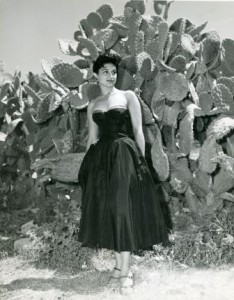From Pageant Queen to U.N. Worker: The Rosemary Hakim Collection
This article is written by Matthew Jaber Stiffler and Elyssa Bisoski of the Arab American National Museum, first museum in the world devoted to Arab American history and culture. AANM is located in Dearborn, Michigan.

The Arab American National Museum (AANM) was built to share the stories of our community. Our walls are lined with family photos and stories of immigration, entrepreneurship, and cultural celebration. Our exhibits honor both the well known stories and the hidden gems of the Arab American experience throughout the last 130+ years. Our library and archival collections also preserve thousands more stories in the form of books, personal papers, and photographs.
One of the most compelling stories in our archival collections tells the story of Rosemary Hakim. The daughter of Lebanese Catholic immigrants, Rosemary was the winner of the first “Miss Lebanon America” pageant in 1954. Her newfound fame earned her a months-long trip to Lebanon as an official guest of the Lebanese government, serving as a cultural ambassador from the Arab American community. Her visit was featured in more than a dozen French, Arabic, and English publications at home and abroad. Her visibility and comfort in the spotlight, as well her ethnic background, landed her a vital role in the Arab States Delegation Office at the United Nations in the 1950s.
Through her position as a clerk, she was privy to and worked diligently on some of the most important developments in the Arab world in the twentieth century, including the Algerian revolution, the Yemeni struggle against British colonialism, and the Suez crisis. In her personal life, she was briefly involved romantically with Prince Fahad al-Sudairi of the Saudi royal family, and their relationship is documented in photographs and letters. She chronicled her life through written notes, journals, her unfinished memoir, and photo albums. After her tenure at the United Nations, she returned to Michigan where she would live the remainder of her life. The Rosemary Hakim collection at the AANM highlights the important work performed by the Arab States Delegation Office in the 1950s, as well as showcases the social aspects of the organization. While Ms. Hakim did collect and preserve internal documents, the collection sheds more light on the galas, dinners, “U.N. beach parties,” and other social functions, as well as the interpersonal relationships between Ms. Hakim and her fellow U.N. employees and the diplomats and dignitaries from all over the Arab world, such as Algerian revolutionary Mohammad Yazid.

The hundreds of photos, letters, books, and Christmas cards that Ms. Hakim gathered during her two-year tenure at the United Nations, illuminates how these Arabs and Arab Americans found time to unwind during the tense era of the Suez Canal crisis and the numerous anti-colonial revolutions of the Arab world. In addition to her collected items, which include personal letters and notes from numerous Arab world leaders and dignitaries, the most illuminating item in the collection is Ms. Hakim’s unpublished memoirs, which offer a fascinating glimpse into her unique Lebanese American experience. Titled “Arabian Antipodes,” the first chapters of the memoirs describe her trip to Lebanon in great detail. She discusses meeting Lebanese relatives for the first time, making official appearances as Miss Lebanon America, and going out on the town with cousins and new friends.

The second half revolves around her life in New York City and particularly her relationship with Prince Fahad. Her description of their relationship exemplifies both the differences and similarities among Arabs and Arab Americans. Although Prince Fahad and Ms. Hakim both identified as Arab, ultimately the differences between a Muslim Saudi Arabian prince and an American Catholic daughter of Lebanese immigrants doomed their relationship from the start. Both enjoyed eating Arabic food, listening to Arabic music, and discussing the current events of the Arab World. However, they different greatly in religion, and their class differences alone meant a marriage was unlikely. Additionally, their differing expectations of the role of women played a major role in the end of their relationship. Although Prince Fahad was happy to spend time with the independent Ms. Hakim while in the U.S., he made it clear that whomever he married would be expected to follow Saudi customs for women, which Rosemary understood as wearing a veil and rarely leaving home. Ms. Hakim, whose Lebanese-American upbringing had no such role for women, was unwilling to take on that Saudi tradition.
The memoirs are available in their entirety on the AANM Collections Online website, along with many of the photographs found in the collection. AANM Collections Online is a part of a new digitization initiative at the AANM, in which we are making previously hidden collections available to the public via the web. Due to her fascinating story, the Rosemary Hakim Collection was chosen to be one of the first five collections to be featured on the website. The collection is still in the process of digitization, and will continue to grow as more items are digitized. The AANM plans to eventually make the full collection available in digital form, as well as the collections of other Arab Americans whose captivating stories are hidden in our archives.
- Categories:


